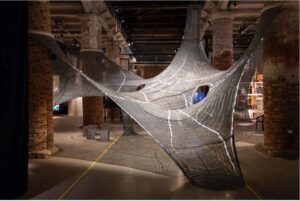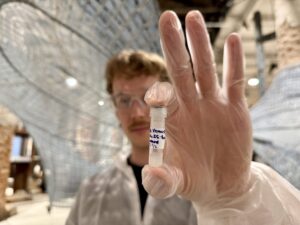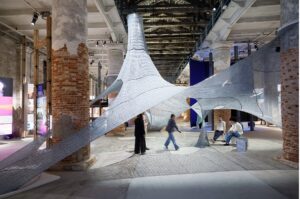
DiDAX members provide DNA-based material passport for Biennale installation Necto
At the 19th International Architecture Exhibition of La Biennale di Venezia, rises the 3D-knitted media architecture ‘Necto’. It is an immersive, innovative, and computationally derived membrane structure, with contribution from DiDAX.
The 3D‑knitted installation Necto stands out not only for its elegant computational design but also for its groundbreaking use of DNA as a data carrier. The textile membrane is made from locally sourced, biodegradable flax fibers, but what makes it truly innovative is a water‑soluble bio‑based coating that stores digital information encoded on synthetic DNA This material passport developed by researchers from the DiDAX consortium, contains details about the materials and machine instructions required to produce the textile itself in the form of 10kB DNA data as copies distributed within the structure.
DNA’s unique properties as a data medium mean that this information remains intact throughout the structure’s entire lifecycle, providing a permanent, embedded record of its composition and origin. By embedding DNA data directly into the material, Necto ensures traceability and verifiable provenance, supporting future recycling, replication, or adaptation.

Leaving no trace
Lightweight and portable, the 3D-knitted strips of Necto arrive on-site in compact luggage, are easily assembled, and tensioned into equilibrium. The structure itself pays homage to Frei Otto (1925–2015) who was a pioneering architect and engineer renowned for his innovative lightweight structures, especially tensile and membrane designs. At the exhibition’s end, Necto dissolves, leaving no trace—its surface flattened and packed, ready to embark on its next life, whilst retaining the digital information about its previous design within the material.
Necto will be exhibited in Venice from May 10 to November 23, 2025.

Collaborative success story
Necto is the result of a global team effort, bringing together architects, engineers, and experience designers who all share one goal: to make a positive impact on the built environment. The design itself is a creative collaboration between architecture studio Solid Objectives Idenburg Liu (SO–IL), Mariana Popescu (computational architect and structural designer at TU Delft) and design and research practice TheGreenEyl.
The technological and scientific basis for 3D knitted formworks is the result of a successful collaboration between TU Delft and the D’Acunto Lab of TU Munich within the EU funded project FlexiFrom. Data storage within DNA is being developed within DiDAX, where the Masania Group at TU Delft developed the composite material concept, Grass Group at ETH Zurich provided the encapsulation and the Heckel Lab at TU Munich encoded the data for DNA storage.
